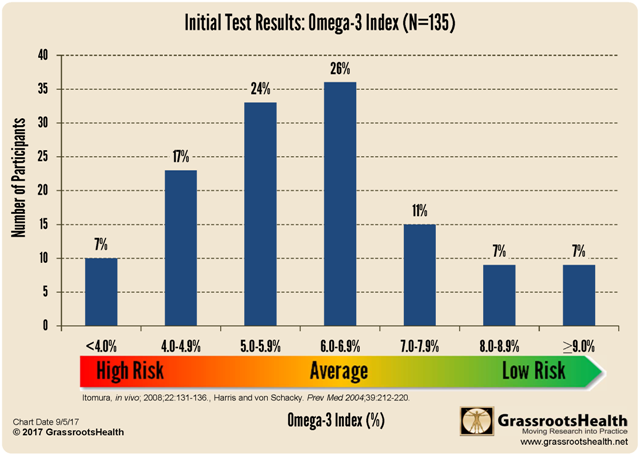Published on February 13, 2018
Healthy Omega-3 levels have been associated with heart health, a longer life, brain health, reduced inflammation, and more.
How much Omega-3 do you have in your blood?
This can be measured with a simple at-home blood test. You prick your finger, drop some blood on a specialized card, mail the card in, and complete an online questionnaire. Within 1-2 weeks from reading this article you can know the relative amount of EPA and DHA is in your blood.
How much do I need in my blood?
The optimal Omega-3 Index is suggested to be 8% or more. Less than 4% is undesirable, and 4-8% is in the intermediate risk zone. The majority of Americans and Canadians are below 4%, while Japanese are typically above 8% due to the amount of fresh fish in their daily diet. Read more about optimal levels of omega-3.
I am probably fine…
You could be, but below is a chart for the first 135 participants in the D*action+Omega-3 home testing project. People who sign up for this project are typically health conscious, exercising, and eating whole foods – yet most are still not within recommended ranges (85% are below an 8% Omega-3 Index).

What do I do after I get my results?
Your results will be given as a percentage, say 5%, and will be accompanied by information about the recommended Omega-3 Index (greater than 8%). You can determine where you would like to be and then use the following:
- Omega-3 Index Calculator – Enter your result and your target Omega-3 Index. This calculator will tell you the additional EPA+DHA needed per day to raise your current level to your chosen target level.
- Omega-3 Supplement Calculator – With the information from the calculator above and your supplement bottle in hand, you can enter information to help you compute how many capsules you need to take daily to achieve your desired Omega-3 Index.
- Vitamin D*calculator – With your vitamin D results you can enter your weight and desired vitamin D level to compute the additional vitamin D supplement intake to achieve your desired vitamin D level.
Make a change, then test again
Experts agree it takes at least 2-3 months to see a change in blood levels. Depending on how drastic a change you are trying to achieve we recommend re-testing in 3-6 months. This may take a few test cycles to really get your Omega-3 (and D) regimen where you want it.
Just like dieting, where you use the scale or a measuring tape to assess your progress, you will use this at-home blood test to see if the changes you made were enough. And, just like dieting, it might take a few iterations to get it right – but the changes in health and prevention will be worth it.

